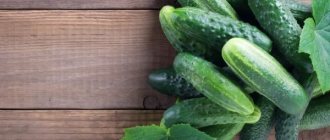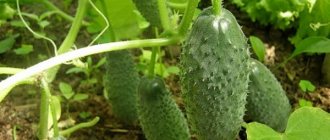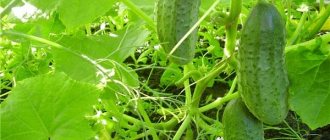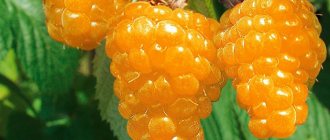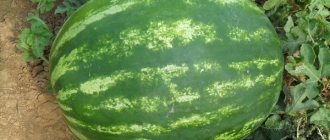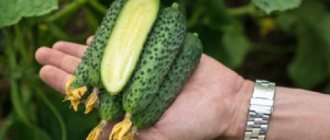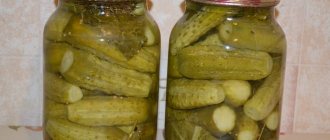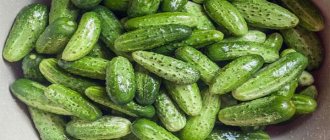Vegetable growing » Cucumbers
0
2073
Article rating
Kira Stoletova
If you decide to plant cucumbers in your garden, first you need to figure out the type that will suit you. In order not to make a mistake in your choice, you need to determine what type of vegetable crop it is. There are determinate and indeterminate cucumbers, which are characterized by certain qualities and are grown in different ways.
Description of determinate and indeterminate varieties
Determinate and indeterminate tomatoes, which are better?
A wide variety of tomato varieties and hybrids creates certain difficulties for the gardener in choosing the right seed material. On the colorful packaging you can find a lot of advertising information about how tasty, large, sweet tomatoes are and much more. However, in addition to definitions that are understandable to everyone, there are terms that are difficult for many vegetable growers. Take, for example, the designation “determinate and indeterminate varieties of tomatoes” found on every package of seeds. We will try to find out what it is and how these cultures differ.
Determinate varieties of pumpkin, buckwheat and legumes
A close relative of the cucumber is the pumpkin, a plant that is distinguished by multi-meter shoots; sometimes it is able to stretch its lashes across the entire plot, overcome the fence and produce a crop in the neighboring plot.
It is very difficult to control the growth of pumpkin shoots. They can grow up to 8 and 10 meters. To avoid filling the area with pumpkin shoots with unlimited growth, it is convenient to plant bush varieties.
Determinate pumpkin varieties are compact in size and very easy to grow. A variety of varieties with limited growth allow you to choose pumpkins based on taste, color and fruit size. The following pumpkin varieties may be of interest to gardeners:
- Spaghetti
- Freckle
- Gribovskaya bush
- Medical
- Bush orange
Determinate varieties of legumes are also in demand: peas and beans. The creation of varieties with shortened stems solves the problems of lodging and shedding, as well as increasing manufacturability during harvesting.
It is worth mentioning cereal plants, the low-growing varieties of which are important for the agricultural industry. For example, much attention is paid to the cultivation of determinate buckwheat.
The growth of its shoots stops with the appearance of a flower cluster at the top, similar to the inflorescence of other cereals, wheat, and rye. In ordinary varieties, a shield is formed. Low-growing varieties are profitable to grow, as they are very resistant to lodging.
A more developed root system provides a better supply of nutrients to the plant, immediately after watering or fertilizing has been done. Nowadays, low-growing buckwheat of the Dozhd and Smuglyanka varieties is in demand.
Based on the above, we can conclude that tall and powerful plants are not always superior in their characteristics and productivity to low varieties and hybrids with limited growth.
To make sure of this, it makes sense to plant both determinate and indeterminate tomatoes, cucumbers, pumpkins and other plants. A good harvest with minimal effort will help you make a choice in favor of certain plants.
Indeterminate tomatoes
These are tall tomatoes that reach a height of two to three meters. The first tomato cluster usually forms above the ninth leaf. Growth can be lengthy depending on weather conditions and usually the top of the bush is pinched to allow the fruits to ripen. In the middle regions, this variety is also quite popular. It is grown both in open ground and in greenhouses. Of course, they are suitable for greenhouses and northern regions, but compared to determinate varieties, the fruits will be later. You can easily spot this variety in your garden or greenhouse. This tomato will be the tallest, almost touching the roof of the greenhouse.
A variety of smooth cucumbers. The best varieties of cucumbers for open ground:
- Cucumber variety German F1. This year I grew these hybrids of two agricultural firms Partner and Aelita. These agricultural companies have 100% seed germination and excellent yield. Cucumbers are firm, tasty, without bitterness. Very good for pickling for the winter.
- Cucumber variety Courage F1. I liked this hybrid because the bush bears many fruits at the same time. This is convenient for me because I immediately collect cucumbers to pickle several jars. The plant showed excellent growth because it is resistant to disease. And even with sudden temperature changes, I did not treat the cucumbers with anything.
These are cucumbers in the open ground today, September 2.
- Cucumber variety Zyatek F1. This cucumber hybrid bears fruit well in open ground. The plant is resistant to major diseases. The fruits are tasty, without bitterness. But the yield of this variety is slightly lower than the two above.
- Cucumber variety Gosha F1. I have been growing this variety for the second year in a row. Last year I planted only in a greenhouse, this year in a greenhouse and in open ground. The hybrid showed high productivity both in the greenhouse and in the garden. I harvested the most from this variety.
- Cucumber variety Shosha F1. The plant has shown its resistance to sudden temperature changes. The hybrid is quite disease resistant. The plant has high taste qualities. These cucumbers are small, so I mainly use them for winter preparations.
- Cucumber variety Bingo F1. I planted this hybrid in the garden mainly for preservation. Since cucumbers grow small, up to 6 cm long.
- Cucumber variety Herold F1. This variety has smooth cucumbers, without tubercles, and light green, unlike other varieties. It was because of its unusual and tasty fruits that I grew this variety.
Popular varieties of indeterminate tomatoes
- Octopus. This is a real leader among indeterminate tomatoes. It has dark red fruits, its distinctive feature is the absence of green spots near the stem. This is one of the year-round varieties, ideal for growing in greenhouse conditions. If you provide him with good conditions, you can grow several harvests a year.
- Major. This is a sought-after variety that attracts gardeners with its very sweet sugar fruits. Thanks to the dense pulp, the fruits easily tolerate transportation, which explains the popularity of the variety in commercial cultivation. Due to the very pleasant taste of the pulp, tomatoes of this variety are constantly used for salads. The color of the fruit is pink, the plant calmly tolerates temperature fluctuations and is not afraid of many diseases.
- Happiness is a tomato variety with large red fruits that have a pleasant smell. Due to the large size of the bush, this variety is preferable to choose for large greenhouses; the bush will grow very quickly. Vigorous growth ensures rapid flowering and fairly early fruit ripening.
- Russian happiness is a variety of the above-mentioned variety. It is characterized by shorter distances between nodes. Because of this, the growth of the bush is smaller, and it is easier for it to find a place in a regular greenhouse. The fruits have another important advantage: they do not crack during transportation and storage, which ensures their preservation for a longer time.
These are just some varieties; the choice for gardeners is much wider. When buying seeds, you need to pay attention to the inscriptions on the back of the bag of seeds: it not only indicates the type of variety, but also indicates basic recommendations for growing.
Benefits of indeterminate tomatoes
- Tomatoes of this variety are very tall. The trunks are tied vertically. This allows the plant to increase the number of brushes. That is, from a small area of these tomatoes you can collect a large number of fruits. A harvest of this variety can produce up to sixteen kilograms per square meter.
- Tomatoes are less susceptible to diseases. Tall tomatoes must be tied to a trellis and the lower leaves and shoots must be removed. This allows access to uniform lighting and air circulation.
- Fruiting of these tomatoes lasts longer, unlike determinate varieties. This allows you to enjoy the harvest from July until the first frost.
- The variety is quite easy to care for. It will be enough for you to form it. You just need to leave one stem and remove the stepsons.
- It is more convenient to work with the plant and harvest while standing, and not in the pose of a summer resident.
Determinate tomatoes
In determinate varieties, the first flower cluster is laid above the 5-7th leaf, and each subsequent one after 1-2 leaves. Such tomatoes, as a rule, are grown in open ground or film tunnels, since there is no point in occupying greenhouses with them - they will not master the required volume there - the height of determinate tomatoes is usually no more than a meter, and most of them do not exceed 60 cm.
Determinate varieties of tomatoes are divided, in turn, into the following types:
- Superdeterminate - plants in which the first inflorescence is located above the 7th - 8th leaf of the main shoot. Growth stops after the formation of only 2-3 inflorescences, so the yield of such varieties is quite low.
- Actually determinate tomatoes are plants with the first inflorescence above the 8th - 9th leaf. The yield is slightly higher because growth is complete after about 5 inflorescences have formed.
- Semi-determinate - plants with the first inflorescence above the 10 - 12 leaf of the main shoot and about 4 side shoots. The fruits ripen, it turns out, later. The fruiting period is even more extended - throughout the entire growing season.
Bush varieties of cucumbers
Readers often ask what bush cucumbers are and whether they can be grown in greenhouses. This is a group of high-yielding, early-ripening bee-pollinated varieties with a female type of flowering, the stems of which do not branch or creep, reaching a length of three meters, but form a bush. The main vine reaches a height of 60 cm, but the side shoots are much shorter. Zelentsy in bush varieties are elongated-ovoid, up to 10 cm long and weighing about 100 g. The varieties Kustovaya, Malysh, Malyutka, Malyshok, Korotyshka are considered the most popular in cultivation.
But since bee-pollinated cucumbers are difficult and inconvenient to grow in greenhouses, bush varieties of cucumbers are usually used for open ground.
Popular varieties of determinate tomatoes
- Bourgeois and Azhur are valued for their large, dense red fruits. Hybrids of this variety are resistant to temperature changes and diseases.
- Kukla, Vesna Severa, Kukla Masha have sweet, large, pink fruits with dense flesh, making them ideal for transportation.
- Denis, Pyshka, Piglet, Gina, Lionheart are among the shortest tomatoes, so they take up little space. Resistant to weather conditions and diseases. Excellent for growing in any way. Most often they are grown in open ground. They do not require sonning.
- Dama, Malyshok, Vehlioka, Golden Horn, Portland, Pink Honey, Asteroid are greenhouse varieties. They require the formation of a bush in the form of one or two stems. It is better to plant bushes at a considerable distance from each other for better yield.
Resistant varieties of cucumbers
In greenhouse conditions, cucumbers most often suffer from downy mildew, powdery mildew, white and root rot, bacteriosis, cladosporiosis, anthracnose and cucumber mosaic virus.
Of all the greenhouse hybrid varieties of cucumbers, the most resistant to powdery mildew and downy mildew (downy mildew) are Anyuta, Vyuga Lastochka, Voyage, Golubchik, Delpina, Quadrille, Julian, Matrix, Nightingale, Lord, Passandra, Strumok, Svyatoslav.
- Sowing vegetables in open ground in March
The most resistant to white and root rot are Break, Nugget, Bianka, Moscow Dude, Autumn Gherkin, Hercules, Connie, Marta, Malvina, Sancho, Topolek and others.
The hybrid varieties Dachny, Rodnichok, Cornet, Crystal, Esaul, Difens, Dvoryansky, Dragun and others are rarely affected by anthracnose.
Cucumber hybrids for greenhouses Adam, Kupechesky, Lord, Anyuta, Danila, Vicenta, Capra, Magnat, Tais, Marinda are resistant to viral mosaic.
Less often than other cucumbers, hybrids Luzhok, Jazzer, Amazonka, Cornflower, Dvoryansky, Amur, Nastenka are affected by cladosporiosis, or olive spot.
Varieties Zodiac, Vzglyad, Epilogue, Crystal, Contact, Royal, Zubrenok show resistance to bacteriosis, or corner spot.
Breeders have developed varieties that are resistant not to one or two diseases, but to a whole complex of diseases. These varieties include Antey, Princess, Bakhtiyar, Ibn-Sina, Leandro, Nightingale, Sister Alyonushka, Pasadena, Opal, Primadonna, Murashka, Natalie and others.
What is the difference between determinate and indeterminate tomatoes?
So, let’s summarize the main differences between indeterminate and determinate tomatoes:
- Seedlings. When shoots appear after 3-4 days, the cotyledon knee straightens and by its length you can indirectly determine the type of future bush. In indeterminate varieties it is longer (3-5 cm) than in determinate varieties (1-3 cm). However, with a lack of light, the seedling can become very elongated and then it is quite difficult to determine what kind of bush it will be.
- Seedling. When the seedlings reach the age of appearance of the first flower cluster, you can easily determine the type of future bush. Indeterminate tomatoes form the first cluster after 8-9 true leaves and above, determinate - after 6-7 true leaves and below.
- Mature plants. When a plant has been planted for a long time, has grown well and has several clusters of fruits, it is difficult to determine the number of leaves before the first ovary, since the seedlings could have been buried and part of the stem remained underground.
Indeterminate varieties plant flowers through 3 leaves. Determinate tomatoes always have less than 3 true leaves between the trusses. On a plant of determinate varieties you can always find a shoot whose growth ends at the ovary; in indeterminate varieties this will not happen. The only mistaking an indeterminate tomato for a determinate one can be when, during the formation of the plant, the shoot is pinched immediately behind the flower raceme and it seems that the shoot has finished growing on it. Therefore, you need to be careful and count the leaves between the ovaries as a check.
Selecting cucumber seeds for planting. What should you pay attention to?
It is better to prepare for buying seeds in advance, in winter or even in autumn. Therefore, hurry up with your choice, the seeds have already changed in the retail chain. Moreover, the range of seeds offered is much greater than the demand. And how can one sort out such a variety of seeds? Let's decide how to choose cucumber seeds. It’s like, what’s special here? All cucumbers are green, some are larger, others are shorter, with pimples, without them, etc. It turns out that there are many criteria, knowing which, indeed, you can harvest a tasty and rich harvest of cucumbers.
What types of cucumbers are there?
First, let's decide for what purposes the grown crop will be used. The main varieties of cucumbers are
Moreover, salad varieties are not suitable for pickling. They have thicker skin and the fruits will not be salted evenly. Pickling varieties contain more sugars. This is what is important when canning. And universal varieties are suitable for preparing salads and pickling. By type of fruiting:
- Ovaries are formed on the side shoots. These include indeterminate varieties. After 5-6 leaves, it is necessary to pinch the top of the shoot so that ovaries form at the ends. On the grown side shoots, pinch the tops again at the level of 8-9 leaves. Only in such cases will you get a rich harvest.
- Determinate varieties and hybrids are more intended for greenhouses; they have one stem, which cannot be pinched, since the entire fruit harvest is formed in the lateral axils of the leaves.
Characteristics of short-fruited cucumbers
Short-fruited varieties are called pickle cucumbers. Most of these varieties have only female inflorescences and also form ovaries without pollination. This feature allows you to grow vegetables at any time of the year in greenhouses or greenhouses. Long-fruited varieties are much more difficult to grow in winter and autumn.
Characteristics of short-fruited varieties:
- The bushes grow quickly; many varieties do not require staking to trellises;
- Cucumbers are small in size;
- The plant forms a large number of ovaries;
- Good yield throughout the entire fruiting period;
- It doesn't take long to grow;
- Ripe fruits taste good;
- Suitable for pickling in its entirety;
- They rarely suffer from various diseases of agricultural crops;
- Bushes do not require special care.
With gherkins you don’t need to spend a lot of time on the site. Their care may be minimal.
Information on the packaging
The packages themselves always indicate information about the vegetable itself, what type it is, the preferred place of cultivation, ripening time, etc. When purchasing, it is important to carefully read the description of the variety and only then decide on the purchase.
Varieties and hybrids
The F1 marking means that this is a 1st generation hybrid. Such crops are obtained by crossing two or more varieties. Hybrids inherit the best qualities from their parents, such as
- resistance to diseases,
- high productivity,
- cold resistance, etc.
You can also find the value “S”, indicating the eliteness of cucumber seeds, which are the direct descendants of the best plants of this species. Generations of elite varieties are also designated by numbers - 1 or 2. Seeds with the designation “S” will be a class higher than “F” and have the best qualities.
Number of seeds
The number of seeds in a package is now calculated in pieces, not grams. To avoid mistakes, when calculating the number of seeds, take into account their germination rate. In cucumbers it is 70%. In other words, out of 10 seeds planted, only 7 will sprout. Therefore, count on 30% more seeds than required.
Landing place
Be sure to determine where you are going to grow cucumbers: in a greenhouse, in warm beds under cover, or in open ground. Therefore, choose seeds based on this criterion.
The packaging should indicate where it is best to grow this variety. If it is written, “the variety is intended for open ground, film cover and greenhouses,” this means the following. Written first, preferred growing location. If “open ground” comes first, then the cucumbers are pinched and they bear fruit on the side shoots. And vice versa, the “greenhouse” comes first, which means you will need to pinch the side shoots so that the formation of ovaries occurs from the axils.
Harvest time
Pay attention to the timing of the first harvest. Fruiting occurs from the beginning of June until September. It all depends on your preferences. Early varieties of cucumbers begin to bear fruit 45 days from germination to harvest. Plus add 7-10 days for fruiting itself. This way you can calculate the duration of fruiting.
Bee pollination
Some packages say “parthenocarpic”, others say self-pollinating, some say bee-pollinated.
- Parthenocarpic – forms ovaries without pollination;
- Self-pollinating - pollinated due to the presence of pistil and stamens in one flower, that is, plants pollinate themselves;
- Bee-pollinated cucumbers are pollinated only by insects, and only then do ovaries form.
Based on this, bee-pollinated cucumbers are planted only in garden beds where there are enough bees and other insects to fly. And in the greenhouse it is better to plant parthenocarpic or self-pollinating ones.
Long-fruited and short-fruited
Long-fruited cucumbers have a very high growth rate. It is enough to plant several plants in the greenhouse - and at the end of June, or even earlier, you will feed your entire family and even your neighbors with cucumbers.
In the minds of many, long-fruited cucumbers are still associated with the “Zazulya” variety, although there are now many other varieties and hybrids. And they are suitable not only for salads. In the green stage, long-fruited cucumbers are perfect for pickling and pickling. Thin, smooth, crispy!
Indeterminate long-fruited varieties - Anyuta, Amazonka, Atlet, Vicenta, Cornflower, Voyage, Hercules, Dynamite, Gingo, Samarodok - are intended for closed ground.
Determinate long-fruited plants - Solnechny, Julian, Svyatoslav - are planted in open ground. You can plant them somewhere near the veranda, they will curl and feed you all summer.
Among protected ground cucumbers there are a lot of short-fruited varieties and hybrids. Summer residents, as a rule, love them more. And they are used for preservation.
Which cucumber seeds to choose?
Hybrids or varietal seeds – what to choose?
Hybrids are characterized by high yields, are resistant to many diseases, and tolerate unfavorable growing conditions. Male and female flowers are distributed relatively evenly on cucumbers. The fruits have a short growing season. The disadvantage is the inability to harvest seeds.
Varietal cucumbers are good because you can collect seeds from them for the next season, since the seeds retain their maternal characteristics. Their fruits are tasty and suitable for pickling and salads. And they tolerate heat well. The disadvantage of varietal cucumbers is their instability to many diseases.
What to choose is up to you. And I told you what to look for when buying cucumber seeds.
Description of determinate and indeterminate varieties of cucumbers
If you decide to plant cucumbers in your garden, first you need to figure out the type that will suit you. In order not to make a mistake in your choice, you need to determine what type of vegetable crop it is. There are determinate and indeterminate cucumbers, which are characterized by certain qualities and are grown in different ways.
Description of determinate and indeterminate varieties
Characteristics of determinate varieties
The main feature of the growth of a vegetable crop is its long weaving stem. Usually they are placed near other beds or tied to a net. Due to the fact that traditional cultivation of bushes brings a lot of inconvenience due to their growth, in greenhouse conditions and when growing in open ground, farmers began to use a determinate variety of cucumbers.
Russia is famous for its rich vegetable harvests and cucumbers are no exception. The determinant type has the following advantages:
- small height (only 50 cm), which will avoid breaking the stem;
- greater productivity;
- Possibility of growing in any conditions.
By planting cucumbers that are limited in growth, you can save yourself from unnecessary work in the form of constant tying and building trellises. Determinate cucumbers are easier to protect from adverse weather conditions.
Growth and development
The development of the stem in a determinate type of vegetable occurs quickly, ending with the formation of a flower bud. After the upper flower cluster is formed, the bush will begin to produce fruitful side shoots, and until then all the buds are barren flowers.
This type of cucumber variety is formed according to the bush type, so the crop grows on the side loops.
Care and planting
Vegetables of the f1 variety are sown at a short distance from each other, so you should take care of the soil fertility in advance and fertilize it. Treatment with humus before planting will have a very good effect on the yield, and watering the soil with a solution of copper sulfate will help to avoid further problems with diseases and pests.
To speed up the growth of shoots and provoke the bush to bear fruit, you should pinch it. This procedure should be done after 6 or 7 leaves have grown. By cutting off the top of the stem, you will stop the growth of the bush, and in return you will receive the rapid development of side vines, on which cucumbers will soon appear.
The side shoots should also be pinched, only after waiting until the lashes have 10 leaves. Subsequently, the same number of fruiting vines will appear on each shoot, which will contain a female flower.
The determinate species has a good yield - up to 3-5 kg per bush. The fruits appear and ripen almost simultaneously, which allows you to harvest more vegetables at one time.
Top 30 best types of determinate varieties of cucumbers with descriptions
When choosing varieties of cucumbers, summer residents focus on taste, ripening time, and the need for pollination. Important characteristics of the cucumber crop are the length and branching of the stem, on which care and cultivation characteristics depend. Let's consider the advantages and capabilities of cucumbers belonging to determinate varieties, as well as some recommendations for planting and care.
Determination as a property of cucumber
Determinate – limited, translated from Latin. Determinate plants stop growing during development; the stem tends to grow only to a certain length. The vines of many popular (indeterminate) varieties of cucumbers last all summer, freeze for a while, then continue to increase in length.
Determinacy is a property of cucumber varieties, one of the characteristics. Growth restrictions may affect different parts of the bush. Types of determinate cucumbers:
- bush;
- with one stem - the cucumber grows with one stem, practically without producing side shoots.
- climbing - after reaching a certain length, the main stem no longer grows, only lateral shoots develop.
When purchasing cucumber seeds, you need to consider how the stem will be formed in order to ensure rational planting, care and obtain maximum yield.
Advantages and disadvantages of cucumbers with limited vine growth
Determinate cucumber species have a lot of supporters and opponents. To understand whether these varieties need to be planted, consider the main characteristics of cucumbers with limited growth.
Advantages of determinate varieties of cucumbers:
- small size of the bush, which greatly facilitates care;
- ease of cultivation in a limited area of a summer cottage;
- simultaneous ripening, which is useful for preparations;
- high quality greens - they do not turn yellow, do not outgrow, are tasty, fragrant, and are stored for a long time;
- cucumbers are good in any form;
- short growing season - due to this they rarely get sick, they simply do not have time to become infected.
The life cycle of many determinate varieties is short; in 2-3 weeks all the fruits ripen; the bush can be removed, freeing up the area for planting greens or other crops. Many summer residents plant determinate varieties to make preparations during abundant fruiting.
Help: these cucumbers do not need to be tied up, trellises built for them, or frequent, regular measures to be taken to protect them from diseases and pests.
As you know, disadvantages are a continuation of advantages. This is exactly the case with determinate varieties. The disadvantages include:
- lower yield than that of indeterminate brothers;
- rapid death of the bush, short life and fruiting period.
Any agricultural technician will tell you that with the friendly growth of the ovaries, plants need abundant regular feeding, so constant and scrupulous care is required during the growing season.
What to consider when choosing determinate varieties
When choosing short-stemmed cucumbers, take into account the main characteristics of garden crops:
- hybrids or varieties;
- in what time frame can the harvest be obtained?
- The most important property of any plant is the method of pollination.
These characteristics help to choose varieties for greenhouses and open ground, for convenient cultivation on balconies and in apartments.
Types of pollination
Bee-pollinated varieties are planted openly; when planting such cucumbers in a greenhouse, you may not get a harvest. If varieties allow both types of cultivation - open and greenhouse, this is indicated on the packaging.
Help: parthenocarpic species are suitable for any type of planting, they are convenient and do not require additional pollination efforts.
Hybrids
It is impossible to obtain seeds from hybrids. Summer residents who like to prepare their own seed should avoid the F1 marking on the bags. This means a first generation hybrid. Hybrid cucumbers - with small seeds that are practically not felt while eating, the bushes are more resistant to diseases and pests.
Ripening time
Most determinate varieties ripen in a short time and quickly produce crops. The varieties are divided according to the usual scheme - early ripening, mid-ripening and late ripening.
Varieties and descriptions of hybrids of bush and short-stemmed cucumbers
Let's look at the most popular types of cucumbers that have good reviews among summer residents. Bush species and crops with limited stem growth are represented here.
Shorty
The variety is intended for cultivation in open ground and is pollinated by insects. It will sing in 40-45 days. The whip does not grow more than 35-40 centimeters. Cucumbers are medium-sized (9-10 centimeters), with thin, delicate skin and a sweetish taste. The fruits in the node grow simultaneously. Cucumbers are consumed fresh and prepared.
The variety is used for open cultivation and is pollinated by bees. It takes 46-50 days before the fruit appears. Cucumbers are ovoid, elongated. Weight – 90-110 grams, many tubercles, dark pubescence. Cucumbers do not overgrow and do not turn yellow if harvesting is delayed. Can be used in any form.
Baby
The bush variety contains up to 6 ovaries in a node; when grown openly, the vines do not grow longer than 30-50 centimeters. Up to 60 fruits are harvested from a bush, the entire harvest is harvested in 2-3 weeks. Cucumbers are bright, with whitish stripes, and lumpy. When overripe, the skin becomes rougher. They are stored well (up to 10 days) without losing the quality of the greens.
Bush gift
Zelentsy are rounded and elongated, with a small number of tubercles. The fruits are ready in 47-53 days. They sing together and do not turn yellow on the bush. Weight – up to 100 grams, length – no more than 12 centimeters. The taste is high, the flesh is dense and fragrant.
Bush
The variety was registered back in 1980, and has not lost popularity among summer residents since then. For open ground, bee-pollinated. Cucumbers are slightly elongated (up to 12 centimeters) with small longitudinal ribs, they lie well and are transported. Crispy, sweetish taste. The crunchiness is retained in the preparations, for which they are valued by gardeners.
Hector F1
Hybrid of Dutch selection. Beautiful cucumbers of a dark shade, dense when cut, without voids. Productive - up to 4-7 kilograms per square meter of area. Ultra-early - ready in 30-35 days. Hector bushes tolerate low temperatures well and do not freeze.
Baby F1
Small, wonderfully tasty cucumbers, without bitterness. Very fragrant and sweet. Parthenocarpic hybrid, ovaries are collected 3-4 pieces per node. Zelentsy are small – 60-90 grams, length – 8-9 centimeters. Suitable for planting in greenhouses and open methods. The first cucumbers are harvested after 40-50 days. The baby is used for consumption in any way.
Buyan F1
A hybrid of Moscow region selection, ripens in 45 days. Suitable for greenhouse cultivation and planting in open ground. Buyan greens are collected in bundles of 3-7 pieces. The fruits are pronounced green in color with lighter tips. The yield per square meter is 9-12 kilograms. Cucumbers are without bitterness, with a good delicate aroma.
Grasshopper F1
Parthenocarpic hybrid with a short ripening period - 40 days. The nodes contain 2-6 ovaries. Cucumbers of the Grasshopper hybrid need to be collected on time; when they overgrow, voids are formed and the central part dries out. Used fresh and in preparations. The fruits are slightly elongated, up to 15 centimeters, weight – 90-110 grams. The surface is ribbed, with white stripes.
Chistye Prudy F1
The fruits grow up to 10-12 centimeters, smooth, of the same shape and size, the surface with rare tubercles. The Chistye Prudy hybrid tolerates growing in shaded conditions well. The taste is sweet, with a pronounced cucumber aroma.
Cappuccino F1
The hybrid is grown in greenhouses and open ground. Cappuccino is consumed fresh and for pickles. Zelentsy – 10-12 centimeters, juicy and crispy in any form.
Climbing varieties
Many summer residents prefer this particular type of determinate cucumber - the stem trails, but does not grow particularly long. The description of the hybrids of these varieties states that they are especially good when collected at the stage of pickles (3-5 centimeters) and gherkins (4-8 centimeters).
Idol F1
High-yielding hybrid, resistant to most diseases. Zelentsy are short (10 centimeters), with large tubercles and edges. The preparations retain their density and crispiness.
Miser
Small cucumbers do not grow more than 8 centimeters, the shape is round. The greens are densely dotted with small tubercles, the color is dark green, with white stripes at the tip. They sing together.
Vyazovets
Bee-pollinated cucumber variety. It is popular with summer residents who like to get their own seeds. Usage is universal. Zelentsy are dark, with sparse bumps, size – up to 15 centimeters.
Juventa F1
The stem grows up to 1.5 meters. The fruits are elongated - 22-24 centimeters, diameter - 4-4.5 centimeters, weight - up to 260 grams. The taste characteristics of cucumbers are excellent, there is no bitterness.
Masha F1
Early hybrid, self-pollinating. There are up to 7 ovaries in the nodes, the yield is 10 kilograms per square meter. Grows well in greenhouses and open ground. The tuberosity is frequent, with white fluff. If harvested untimely, the taste deteriorates and the skin becomes coarser. Cucumbers are prepared for future use by any means; they are also delicious fresh.
Cucumbers have limited stem growth, high yields, and are grown industrially, among other things. Excellent taste, mid-season variety. Greens – 7-10 centimeters, sweet and crunchy.
Hope
An ultra-early ripening variety of cucumbers with cylindrical fruits weighing 80-95 grams. Ovary - in bunches of 3-7 pieces. Excellent taste characteristics, the possibility of canning and pickling make the Nadezhda variety popular and beloved among summer residents.
F1 debut
Hybrid with a stem of limited growth, short climbing. Cucumbers are bright green in color, with light stripes from tip to center. Lumps are infrequent and unexpressed. The high-yielding hybrid is grown in greenhouses, tunnels and open methods.
Sturdy F1
Zelentsy are cylindrical, 8-11 centimeters. The location of the ovaries is in nodes of 5-7 pieces. The hybrid is classified as early ripening and tolerates any weather conditions well without reducing yield. Cucumbers are used fresh and in preparations.
Dimka F1
Short cucumbers (7-9 centimeters) grow evenly, all fruits are of the same type and size. If collected untimely, they do not turn yellow and do not outgrow. Taste characteristics – no bitterness, crispy, juicy, without voids.
Vigora F1
The first wave of fruiting is early; later the cucumbers will ripen until late autumn. The total yield is 10-12 kilograms per square meter. Zelentsy - 10-12 centimeters, dense, with small tubercles, weight - less than 100 grams.
Cucumber crops without side shoots
Another type of determinants are single-stem bushes with no lateral branches. At the end of the season, groups of ovaries often form, growing in a bouquet, that is, an organized group of cucumbers.
Artel
The parthenocarpic species produces the first greens in 40-43 days. If there are a lot of cucumbers, the stem does not grow more than 1 meter. Sometimes it stretches up to 1.5-2 meters and produces side shoots. There are 3-4 ovaries in the nodes. Cucumbers - 9-12 centimeters, with small frequent tubercles. Most of the fruits grow in the first 90 days of fruiting.
Arshin
The fruits grow on one stem, which often does not exceed 70-90 centimeters. The cucumbers are smooth - 9-11 centimeters, weight - 90-120 grams, the bumps are infrequent, there are white stripes on the surface.
Determinate varieties
The species can be determined by the description
When choosing seeds for planting, pay attention to the method of growing the vegetable. If the packaging says that a crop can grow in open ground conditions, as well as in a greenhouse, it is definitely a determinate variety. Of course, you can’t tell the difference between seeds by their appearance, but based on the development conditions and growth rules, you can easily determine which species is in front of you.
The most common types can be named:
- Vyazemsky 37 is a low-growing vegetable crop with excellent taste, mid-season. The fruits are sweetish, dark green in color, oblong.
- Hybrid Hector f1. It has the appearance of a bush, the fruits are small, neat, crispy. Versatile to use.
For balconies and windowsills
Those who like to grow cucumbers on the balcony should pay attention to the varieties Balagan, Calendar, Kolibri, and Machaon. These short-fruited cucumbers will yield a harvest on the loggia or in the apartment if you follow the necessary rules: the volume of soil must be no less than
40x40x40 cm, the duration of daylight in winter should be increased with the help of a lamp.
Any low-branching cucumber varieties intended for greenhouses will bear fruit well in an apartment.
It is better to feed cucumbers growing at home with liquid fertilizers: after all, their roots are in limited containers and do not have full respiration. By the way, the expert recommends making additional holes in the side walls of containers for cucumbers from the inside (to avoid hangnails) for better breathing.
Characteristics of indeterminate varieties
Russia has its own state register, which includes the most grown indeterminate varieties of cucumbers. Almost all f1 hybrids are immediately approved by leading farming experts.
When choosing seeds for planting, pay attention to the instructions. If the purpose is written only for greenhouse cultivation, then we are talking about an indeterminate species.
Growth and development
The bush develops in height, reaching 1.5 m in height or more. Indeterminate bushes do not require pinching as long as they have sufficient light and a comfortable temperature.
The bush will not grow in width. All main ovaries pass along the main stem. The plant continuously grows and develops, producing more and more new crops.
Care and planting
Planting is carried out in greenhouse conditions. The crop is planted at a distance of 25-30 cm between the bushes. First, the soil is mulched and aerated.
Manure is perfect as a fertilizer, in the amount of one bucket per 1 square meter. You will need to tie up the stems and build a support.
